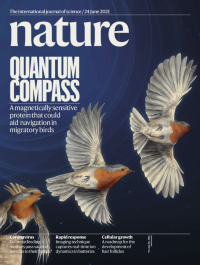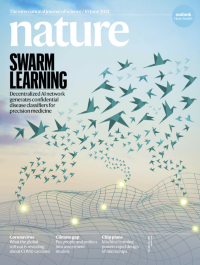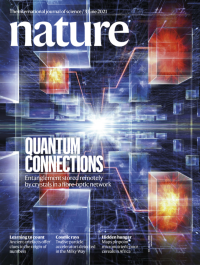Volume 594
-
No. 7864 24 June 2021
Quantum compassMany creatures use Earth’s magnetic field to help them navigate, but the exact nature of this internal compass has remained elusive. In this week’s issue, scientists from the Universities of Oxford and Oldenburg reveal the quantum properties of a protein that makes it a strong contender for the compass in migratory songbirds. The researchers examined the protein cryptochrome (ErCRY4), which is found in the retina of migratory European robins (Erithacus rubecula), and found that it could have the required level of magnetic sensitivity to act as a light-dependent compass. They identified that in vitro ErCRY4 undergoes a light-driven chemical reaction that triggers quantum effects that might enable sensing of magnetic signals. The team also found that the molecule in robins has greater magnetic sensitivity than the equivalent protein in non-migratory pigeons and chickens, leading them to conclude that it is likely to be a key component in the way robins navigate.
-
No. 7863 17 June 2021
Team scienceMore than ever, science is a team effort, bringing together multiple disciplines and geographical regions. At their best, collaborations foster greater understanding, respect and trust, as well as deepening our knowledge. In this week’s special issue, we take a look at how the nature of collaborations is evolving, and offer some examples of how to keep collaborators working in harmony — as well as suggestions for how to stop things going awry. The global changes wrought by the pandemic have exerted a significant effect on global trends for collaborations, as well as helping to drive initiatives to find ways to tackle COVID-19. More locally, carefully managed collaborations can bring communities together, whether to tackle a water-supply crisis or to monitor endangered species. But any collaboration requires astute organization, including dealing with potential barriers and ensuring that due credit is fairly assigned. The complexities of these processes and the need for guidance are captured in the cover image, which takes its inspiration from the iconic Haynes vehicle repair manuals.
-
No. 7862 10 June 2021
Swarm learningA key element of precision medicine is rapid and reliable detection of patients who have a severe illness. Machine learning can help to achieve this, but implementing an effective system that maintains appropriate data confidentially is a challenge. In this week’s issue, Joachim Schultze and his colleagues show that swarm learning — a decentralized AI approach that unites edge computing, blockchain-based peer-to-peer networking and coordination — can be used to tackle the problem. The researchers used swarm learning to develop disease classifiers for leukaemia, COVID-19 and tuberculosis based on 16,400 blood transcriptomes and 95,000 chest X-rays. The classifiers outperformed those developed at individual medical facilities while fulfilling confidentiality regulations. The team notes that the distributed nature of swarm learning coupled with blockchain technology enables it to make use of large data sets without compromising on confidentiality.
Nature Outlook
-
No. 7861 3 June 2021
Quantum connectionsThe ability of quantum networks to distribute and store entanglement at remote, interconnected nodes would enable applications such as quantum communication, quantum sensing or distributed quantum computation. In this week’s issue, Hugues de Riedmatten and his colleagues present heralded entanglement between two remote solid-state quantum memories. The entanglement is heralded by detection of a photon in between the two memories and is stored in the memory crystals for up to 25 microseconds. Moreover, the set-up uses photons with a wavelength suitable for fibre-optic telecom networks, which offers the possibility of operating quantum networks and quantum repeaters with existing telecommunications infrastructure. The cover image offers an artistic interpretation of the system. The two crystals are connected to a telecommunications fibre-optic network and the photon heralding the entanglement (at the centre) generates the two possibilities, represented as mirror images on top of each other, of one of either of the crystals being in an excited state. In related work in this issue, Chuan-Feng Li and his co-workers present heralded two-photon entanglement between two quantum memories 3.5 metres apart.




